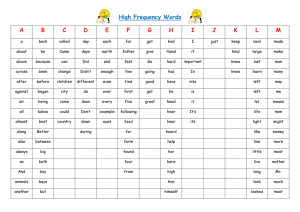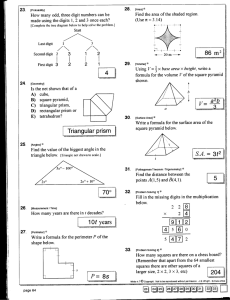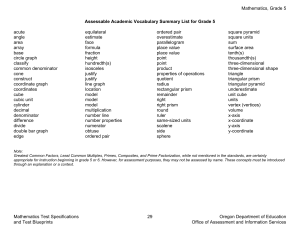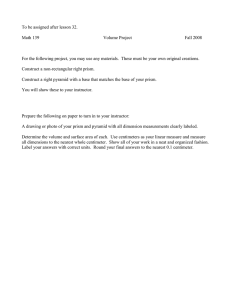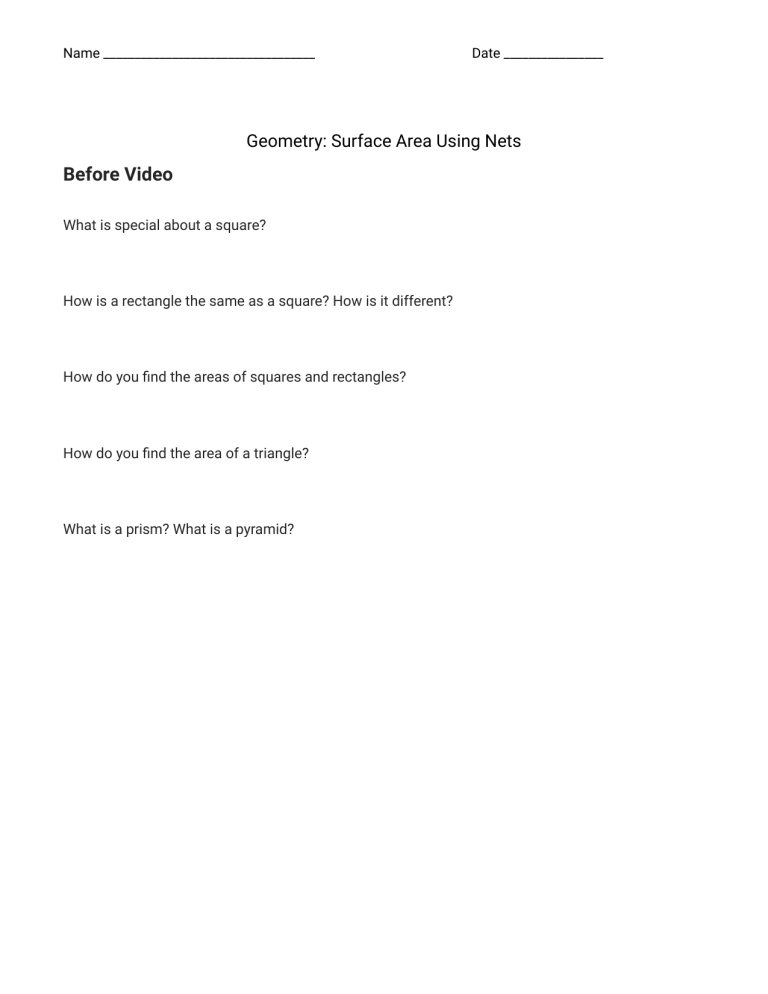
Name __________________________________ Date ________________ Geometry: Surface Area Using Nets Before Video What is special about a square? How is a rectangle the same as a square? How is it different? How do you find the areas of squares and rectangles? How do you find the area of a triangle? What is a prism? What is a pyramid? After Video What 3D shape consists of six squares? How would you find the surface area of a cube? How does finding the surface area change if the prism’s sides are not squares? How is the net of a prism different from the net of a pyramid? How do you draw a 2D net that represents the same surface area as a 3D shape? Vocabulary AREA = The amount of space, in square units, inside of a 2D shape (for example, for a rectangle, area is length times width; for a triangle, area is half the base times the height). DECOMPOSE = To break apart a shape (or quantity) into smaller parts. SURFACE AREA = The total area, in square units, of the surface of a 3D object. NET = An unfolded, flat picture that represents a 3D shape. RECTANGULAR PRISM = A 3D shape that has six faces that are all rectangles. CUBE = A special rectangular prism that has six faces that are all squares. PRISM = A 3D shape with two identical bases connected by three rectangular faces (for example, in a triangular prism, the bases are triangles; in a pentagonal prism, the bases are pentagons). RIGHT TRIANGLE = A three-sided polygon that contains a 90-degree angle. PYRAMID = A 3D shape that has 5 faces (for example, in a rectangular pyramid, 4 triangular bases are built along a rectangular base, and meet at a point). Name __________________________________ Date ________________ Geometry: Surface Area Using Nets Before Video What is special about a square? All sides are congruent (same length) and all angles are congruent (right angles). How is a rectangle the same as a square? How is it different? A rectangle still has four congruent (right) angles. They have two pairs of congruent sides, i.e., only opposite sides have the same length. How do you find the areas of squares and rectangles? For any rectangle, I can multiply length by width, or base by height. If it’s a square, I can multiply one side length by itself. How do you find the area of a triangle? Base times height divided by two, or half the base times the height. What is a prism? What is a pyramid? A prism is a solid object with two identical ends and flat sides connecting them. A prism where all of the sides are squares is called a cube. A pyramid is a solid object where there is a polygon on the base and the sides are triangles that meet at a point at the top. After Video What 3D shape consists of six squares? Cube. How would you find the surface area of a cube? Find the area of one face, then multiply by 6. How does finding the surface area change if the prism’s sides are not squares? I have to add up all of the face’s areas, some of them might be triangles or other shapes. How is the net of a prism different from the net of a pyramid? The prism consists of rectangles along with whatever shape the two bases are. The pyramid has triangles along with whatever shape the one base is. How do you draw a 2D net that represents the same surface area as a 3D shape? Picture unfolding the shape until it lies flat, and make sure that only congruent sides are touching. Vocabulary AREA = The amount of space, in square units, inside of a 2D shape (for example, for a rectangle, area is length times width; for a triangle, area is half the base times the height). DECOMPOSE = To break apart a shape (or quantity) into smaller parts. SURFACE AREA = The total area, in square units, of the surface of a 3D object. NET = An unfolded, flat picture that represents a 3D shape. RECTANGULAR PRISM = A 3D shape that has six faces that are all rectangles. CUBE = A special rectangular prism that has six faces that are all squares. PRISM = A 3D shape with two identical bases connected by three rectangular faces (for example, in a triangular prism, the bases are triangles; in a pentagonal prism, the bases are pentagons). RIGHT TRIANGLE = A three-sided polygon that contains a 90-degree angle. PYRAMID = A 3D shape that has 5 faces (for example, in a rectangular pyramid, 4 triangular bases are built along a rectangular base, and meet at a point).
